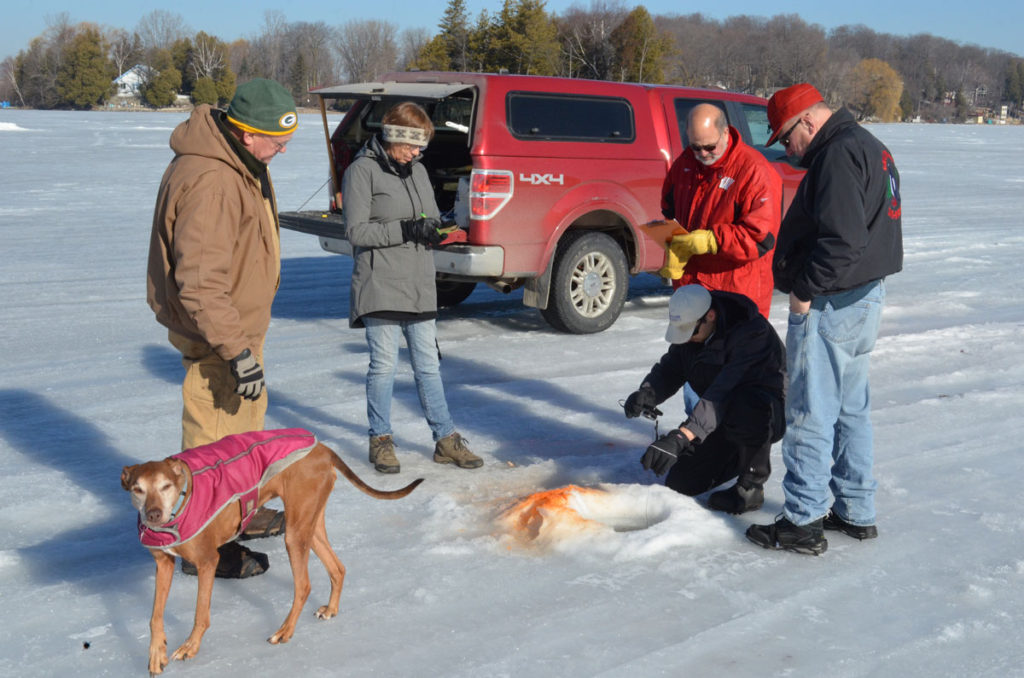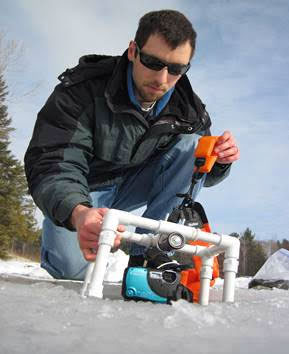
With ‘Betty’ looking at the photographer Scott Otterson: Dick Grossenbach, Hanna Edelglass, Paul Skawinski, Dick Jens and Phil Knauf.
An Event Report By MCLA Member Hanna Edelglass
March 7, 2017—On Friday, the 17th of February, Paul Skawinski, Coordinator of the Wisconsin Citizen Lake Monitoring Network, UW Extension Lakes Program University of Wisconsin; Stevens Point, hosted an all day Citizen Lake Monitoring Network meeting with volunteers, sponsored in conjunction with Sanitary District #1, Cedar Lake. The field event involved sampling aquatic invasive as well as native species, at Cedar Lake. This was an opportunity to predict, through holes drilled in well over a dozen places, what we can expect to do to keep our lakes healthy year round.
On a relatively warm day, with water collecting steadily on the ice, Dick Grossenbach, who drilled the holes, Scott Otterson, Phil Knauf, Dick Jens, and myself, drove out to the many drilled holes. Everywhere the ice was between 16 and 18 inches thick, and the water depth at the holes varied from a few feet near the shoreline to around 20 feet. Paul first lowered a small camera, holding it by a thin cable, which sent images back up to a small handheld screen. A second camera was used to obtain better images or video when necessary. Paul built a cage to house and protect this camera, along with an underwater floodlight to illuminate the area around the camera.

PAUL SKAWINSKI, Coordinator Wisconsin Citizen Lake Monitoring Network, UW Extension Lakes Program University of Wisconsin; Stevens Point, sponsored in conjunction with Sanitary District #1, Cedar Lake
Paul pulled the cameras out of the water, and we were then able to see the types of life that existed at each location. Plants, invertebrates, and fish were seen living at nearly every location. We found zebra mussels in a few places and Eurasian watermilfoil mostly near the boat landing. The invasive Eurasian watermilfoil needs to be removed because it can reduce the biodiversity of a waterbody, and reduce aesthetic and recreational qualities. We also discussed the existence of hybrid watermilfoil in Wisconsin, although no hybrids have been seen in Cedar Lake. This is a hybrid between the native northern watermilfoil and the invasive Eurasian watermilfoil. In the past, Cedar Lake has controlled Eurasian watermilfoil with a weed harvester and herbicide treatments. It is important to allow native aquatic plants to grow in the lake, which help keep Cedar Lake healthy for fishing, swimming, diving and all kinds of boating.
At several holes, we saw bluegills, which feed on invertebrates like the small, shrimp-like Isopods (also called aquatic sowbugs). We raked up samples of aquatic plants in some of these holes, and saw Isopods crawling out in all directions, especially when we pulled up a small plant called Chara. We also observed many types of pondweed, arrowhead, and other native aquatic plants.
The ice cover still admits a lot of light that supports plant growth. Even through 16 or more inches of ice, we found 13 species of plants growing in Cedar Lake. While the ice cover allows light to penetrate into the lake, snow cover can quickly block out light from plants in the lake. Near the boat landing, we saw a large Eurasian watermilfoil plant covered in algae. We speculated that this sudden increase in algae could be due to a nearby drainage ditch that delivers phosphorus-rich water to the lake.
We discussed the wisdom of installing ‘fish sticks’, which is a method of adding downed trees to the water. The trees provide refuge for fish, turtles, and other creatures. The Wisconsin Department of Natural Resources offers cost-sharing for this practice. Applying for permits is essential.
Paul collected and bagged what we found for further inspection.
Volunteers can make all the difference by looking for invasive species near boat landings and near their properties, marking the spots where they found them, and reporting them to a Wisconsin Citizen Lake Monitoring Network coordinator. These staff are located around the state, with our local contact being in Green Bay.
What we are doing, and what is effective, is accessible to everyone. And we need your input, what you value and what concerns you about your lake.
By Hanna Edelglass
with much appreciated input by all who spent a day on the ice.


We know we have longstanding Eurasian milfoil on Horseshoe Lake and wonder if it’s feasible to have the harvester device take a visit to our lake? Presently we just rake it out along our property shoreline but it is present generally around the lake and second lake access.
James,
Our harvester is quite large, and while we do have a trailer for it, the trailer is not really meant for highway traffic. It is just to get the harvester in and out of the lake for winter. Have you tried to get a grant to chemically treat your lake. We do this in addition to the harvester. Also, the harvester does not cut down to the bottom, so it wouldn’t do you much good.
Dick Jens
Cedar Lake